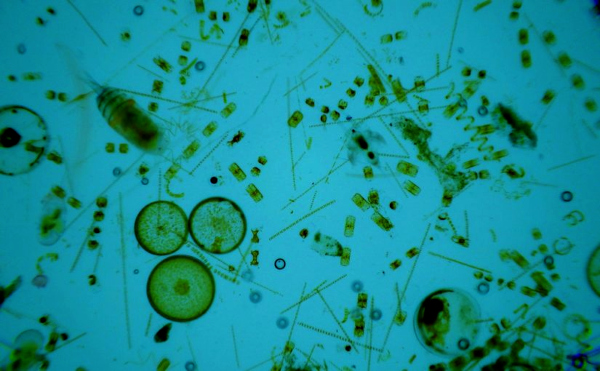Phytoplankton, which are tiny microscopic plants found in the ocean, are important ecological indicators regulating life in our ocean. Scientists for many years have been studying phytoplankton biomass by analyzing chlorophyll-a, a dominant pigment found in phytoplankton cell. The scientists are now capable of measuring the quantity of the chlorophyll-a present in a particular area of the ocean, in real-time. Phytoplankton contributes more than half of the oxygen that we breathe. That apart, they influence our climate by absorbing human-induced carbon dioxide, a heat-trapping greenhouse gas. In addition to the above, phytoplankton also serves as the base of the ocean food chain. Their abundance determines the overall health of the ocean ecosystem.
Given their importance, a team of scientists from INCOIS closely tracked the long-term trends of chlorophyll-a in the northwestern Bay of Bengal. They also studied the co-existing factors that affected the increasing pattern of chlorophyll-a. They reported the outcome of the work in the journal of Environmental Science and Pollution Research. The study was based on in-situ and satellite data spanning over the last 16 years. They observed significant increase of chlorophyll-a concentration during pre-southwest monsoon seasons. The other parameters studied are total suspended matter (TSM) and colored dissolved organic matter (CDOM), which are optically active substances in water. TSM and CDOM were observed with maximum spatial variability during the southwest monsoon period in the northwestern Bay of Bengal coastal waters. It was conspicuous to note that there were two peaks of chlorophyll-a taking place — the primary peak occurred during the pre-southwest monsoon due to the recurrent phytoplankton bloom in the coastal water. Whereas, the secondary peak occurred during the end of the southwest monsoon, spreading to far offshore areas.
Apart from phytoplankton bloom contributing to this increase of chlorophyll-a in nearshore waters, the study found physical forces such as upwelling, wind-induced vertical mixing, convective overturn and local circulation pattern influenced the peaks by supplying dissolved chemical input from various sources including river/terrigenous runoff. This kind of information on marine environmental parameters is now becoming increasingly important as they serves as a basis for monitoring climate change, river discharge, and the impact of pollution in the ocean.
Phytoplankton contributes more than half of the oxygen that we breathe. That apart, they influence our climate by absorbing human-induced carbon dioxide, a heat-trapping greenhouse gas. The study was for a long period from January 2003 to December 2018.The INCOIS scientists started collecting data for the trend analysis of the chlorophyll-a relying on NASA’s MODIS (Moderate Resolution Imaging Spectroradiometer) sensor onboard Aqua satellite acquiring data in 36 spectral bands. Additional satellite data from NASA’s VIIRS (Visible Infrared Imaging Radiometer Suite) sensor onboard Suomi National Polar orbiting Partnership (NPP) satellite and ISRO’s OCM-2 (Ocean Colour Monitor-2) onboard Oceansat-2 satellite. INCOIS scientists processed the satellite data using NASA’s Sea-Viewing Wide Field-of-View Data Analysis System (SeaDAS) software which detected chlorophyll-a pigment magnitude in the ocean. The team has come up with important result that NASA’s MODISA sensor data is more reliable and near to accurate in providing the information on chlorophyll-a concentration in coastal waters of the Bay of Bengal.
The piece of work reveals that the study area experienced maximum spatial variability during pre-southwest monsoon with salinity, and nutrients, the major controlling factors for the abundance and distribution of phytoplankton. The study further said though such trends could tell an overall improved health status of the ecosystems as a whole; at the same time they could be detrimental to ocean health because of eutrophication. Land run-off that deposits an excess of nutrients from agricultural land to the coastal waters facilitates growth of harmful algal blooms at large scale. These harmful algal blooms deplete the oxygen level in water disrupting the ocean ecosystem. The result is oceanic fauna such as fish assemblages are badly affected leading to decline in fish catch.
Like terrestrial plants, the ecofriendly phytoplankton is largely dependent on light, temperature and nutrients. It is therefore, continuous monitoring of the ocean ecosystem is the need of the hour to devise mitigation system to encounter disruption caused by algal bloom because of excessive phytoplankton enrichment in the coastal water.
Led by Dr. AneeshA.Lotliker, the research team comprised of Dr. Sanjiba K.Baliarsingh, Dr. T. Srinivasa Kumar of INCOIS, Hyderabad, Ministry of Earth Sciences, and Prof. Kali C. Sahu of Department of Marine Sciences, Berhampur University, Odisha.
Source: Vigyan Prasar
You may also like
-
New Heat-Based Approach To Cancer Treatment Can Reduce Chemotherapy Doses
-
Scientists Take A Major Step Towards Unification Of Classical & Quantum Gravity
-
India Graphene Engineering and Innovation Centre (IGEIC) Under the Vision of Viksit Bharat@2047 Launched
-
New High-Performance Gas Sensor can Monitor Low Level Nitrogen Oxides Pollution
-
Antidepressant Drug can be Repurposed for Treating Breast Cancer
